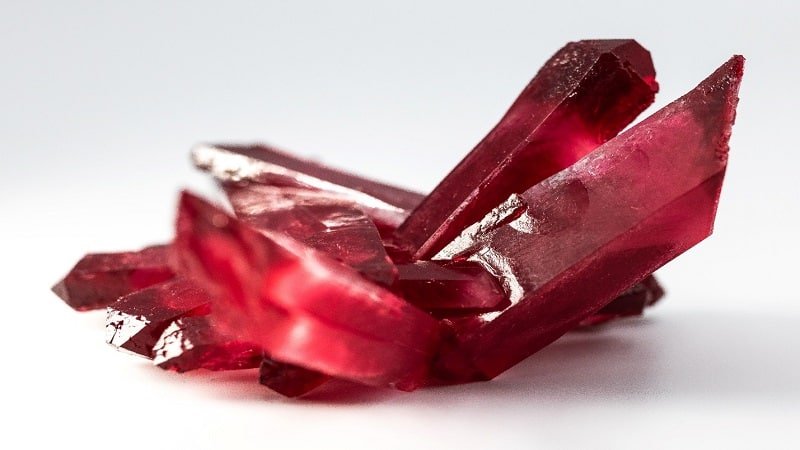What is Red Beryl?

Table of Contents
You might confuse ‘red beryl’ with ruby because of its red color, but you would be surprised to know that both gemstones have nothing in common except for the color. Red beryl and rubies are totally different gemstones; red beryl is a popular variety of the beryl mineral species (like aquamarine and emeralds), while the latter is a collection of corundum mineral species (like sapphires).
As understated as a gemstone, it is quite rare and can be considered the crystal in the gemstones category because it can only be formed in a specific geochemical environment.
So let’s take a deeper look at what is red beryl with its formation and colors?
Red beryl: Formation and Colors
The scientific definition of red beryl would be hard to swallow, let alone to understand, because the gemstone is a mineral composed of beryllium aluminum cyclosilicate. To begin with, beryllium is a strong, lightweight, alkaline earth metal. Aluminum also has a lower density than other common metals. This means that two-thirds of red beryl is composed of just metals.
Cyclosilicates, the third component making up red beryl, is ring silicates with more than three tetrahedra forming a ring shape. With the beryl having six units and this component is the mineral aspect of it. Thus, it has a complex chemical formula. Red beryl is quite an understated mineral that is considered a gemstone. Its more famous counterparts include emerald and aquamarine.
Formation
Red beryl is that gemstone whose naturally occurring formation is in hexagonal crystals which can be as high as several meters; so a cave of red beryl would seem like an image taken from a fairytale of a crystal cave.
Colors
The actual color of pure beryl is always transparent; it is the impurities that taint it with colors such as blue (aquamarine), green (emerald), yellow and red (which is the rarest of all). The yellow version of beryl is often known as morganite.
Why is Red Beryl so Rare?
Red beryl can only be found in one country in the world, and guess which one it is? None other than the United States of America. That is one of the reasons why it is so rare. Red beryl can only be formed under a special geochemical environment. Otherwise, you would still get beryl, but it may not be in bright red.
Historically red beryl was formed when groundwater filters through the porous surface to mix in with a rhyolitic volcanic rock, which created a hydrothermal chemical reaction resulting in the formation of red beryl. Due to the nature of how red beryl is formed involving water and volcanoes, it is no wonder that the gemstone is a rarity.
The Value of Red Beryl
Since red beryl receives its beautiful and deep red color from the manganese and with limited supply, it is quite valuable. Its value can be estimated from the fact that it is 1000 times worth more than gold. Come to think of it, we think gold is the almighty investment, but it seems to be leagues behind when placed next to red beryl.
Its value was discovered in 1904 by Maynard Bixby, who discovered the gemstone in the Thomas Range located in Juab County. Another way of understanding the value of red beryl is that only one red beryl is found for every 150,000 diamonds that are mined. So two-carat red beryl is believed to be as rare as a 40-carat diamond. The only largest known red beryl to have been mined as yet is 8 carats. It is famous as the ‘scarlet emerald’ or the ‘red emerald’.
Where is Red Beryl Used?
All gem connoisseurs love red beryl, and because of how rare it is and its category of inclusion into gems, it is used in luxury jewelry items. For instance, a bracelet by Equatorian Imports has 24.12 total carats of red beryl and 4.78 carats of diamonds in platinum, making it one of the most expensive bracelets.
Many mineral collectors also buy it for its unique hexagonal crystal shape and raspberry-red color.
Why is Red Beryl so Understated?
The world discovered red beryl at the beginning of the 20th century, which is the reason why it is just beginning to be presented in the market. As much as its rarity makes it valuable, it also makes sit obscure because this gemstone takes centuries to form and was not discovered by earlier generations. As a result, people have yet not registered the fact that there could be something more valuable than emerald or gold, which is only found in a few caves in the world.
It is a shame that no one yet has registered the importance of red beryl, and that can also be due to its name with ‘beryl’ which isn’t a popular name for a gemstone. That is why now jewelers are told that it is ‘scarlet emerald’, so they treat it with as much care as its green counterpart.
Our Final Thoughts
We hope that this served as an interesting read for you to get to know more about red beryl. Maybe next time, you might want to visit the caves where it is mined to appreciate Nature’s rarest gemstone ever.